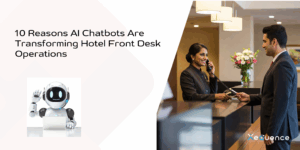- Home
- Artificial Intelligence
- 7 Effective Strategies to Reduce Waiting Times at Hotel Reception
7 Effective Strategies to Reduce Waiting Times at Hotel Reception
- June 8, 2024
- Suraj Kumar
- Artificial Intelligence, Guest Experience, Hotel Management

What is the easiest ways of managing customer wait time
Morning sets the tune for the whole day. Likewise, a guest’s first experience at hotel reception sets the tone for their entire travel or stay. Therefore, the first impression is important in the hospitality sector. Any delay in check-in or check-out can cause annoyance or discomfort to the guests. It is directly related to customer loyalty and reviews. Hotels have to use tactics that reduce wait times and improve the entire visitor experience if they want to guarantee a seamless and effective operation. Using technology, streamlining administrative procedures, boosting worker morale, improving communication, and providing other check-in and check-out alternatives are some of the efficient ways that this article looks at cutting down on hotel reception wait times.
Is it necessary to reduce customer waiting time?
Cutting down on wait times is very important for the hotels to improve guest satisfaction. It will eventually lead to increased loyalty and favorable evaluations. It also lessens client annoyance, which makes them less likely to look for alternatives. When customers are unhappy about long wait periods, they might be greatly eased by a genuine apology and acknowledgement of the hardship. A dedication to meeting client needs is evident when one offers substitutes, including self-service choices or rescheduling opportunities. Today we are going to give you a highlight on the ways of reducing customer waiting time comes inside the banner of hospitality service.
Newsletter
Get regular updates on data science, artificial intelligence, machine
What are the easiest ways of managing customer wait time?
Communicate With the Customer
Improved communication is essential for a satisfying customer experience when they are waiting. Maintain educated and involved consumers by using digital displays and frequent updates. By managing expectations, this proactive strategy lowers the perception of waiting times. Easing the waiting process can also be accomplished by offering amusement or educational materials. Businesses may enhance customer satisfaction and foster a more enjoyable and memorable experience by placing a high priority on good communication, which in turn builds customer loyalty and reputation.
Set up check-in and check-out kiosks
You can add check-in and check-out kiosks to shorten the wait times for your clients. Your clients can check themselves in with these machines when they arrive. To pay for their stay, selecting a room, and receiving their room key, all they need to do is input their details at the kiosk. The guests can bypass the front desk and move into to their room if the hotel management system uses these kiosks. Your client can utilize a kiosk to complete their bill and return their room key at the time of check-out.
Set the Expectation
The guest/buyer can mentally get ready for the wait by following this easy procedure. We probably would have gone for a stroll, grabbed something to eat, or gone shopping next door if we had been informed that we would be waiting for more than an hour. Notifying guests in advance of particularly lengthy wait times is only common decency.
Employee Training
An excellent customer experience can be created by those chosen to work in front-line positions. The ability to handle waiting clients, provide information, and handle problems should be taught to staff members. Because they know what to do, a well-trained staff member may make a bad client experience delightful during hotel check in.
Create a pleasant waiting area
Good waiting environments are appreciated by all. There should be aesthetic appeal, cleanliness, and upkeep in reception spaces and waiting rooms. Someone should at the very least have a cozy spot to sit if they must wait for a service. Customer agitation and poor preparation for a positive service experience might result from crowded and noisy waiting area. Guests frequently “spread” out, so provide lots of chairs because people dislike having to search for a seat. Make sure that your waiting spaçe can hold more individual or guest than there are anticipated to be in line at any given time.
Service Recovery
Workers should be prepared to conduct service recovery and put the customer’s concerns right, just like in any case where they have a negative experience. This could take the form of a simple, sincere apology or something more complicated, like fully or partially writing off a bill. For instance, when there are lengthy delays or subpar food, I have seen restaurants deduct some of the price. The check in hotel service experience is something that organizations all too frequently lose sight of because they are too preoccupied with “performing a service.” Taking a moment to evaluate your service from the perspective of your customers and making necessary improvements could help guarantee that they receive an experience that not only fulfills their needs but also surpasses their expectations.
Monitor and Manage Customer Flow in Real-Time
Minimizing wait times requires careful attention to detail and real-time control of client flow. Businesses can use feedback systems and cutting-edge technology to dynamically distribute resources to match current demand. Assuring a seamless and effective service experience, this agile strategy allows for proactive modifications. Businesses can maintain maximum operational performance and successfully handle possible bottlenecks by remaining sensitive to fluctuations in consumer flow. This approach can result in increased customer satisfaction and loyalty.
Conclusion
Through smart staffing decisions, predictive analytics, and expedited procedures, businesses can successfully cut wait times while also raising customer satisfaction. The best use of resources is achieved by utilizing cutting-edge technologies such as real-time monitoring and queuing systems. The importance of this endeavor cannot be emphasized since it increases positive word-of-mouth, client loyalty, and operational efficiency. When companies react quickly to high wait times with empathy and solutions, they establish trust and enhance their brand. The path to long-term success and expansion is ultimately laid by this customer-centric strategy.
Newsletter
Get regular updates on data science, artificial intelligence, machine
Recent Posts
Newsletter
Get regular updates on data science, artificial intelligence, machine
You may also like

5 Myths About AI in Hospitality Operations | Facts Every Hotelier Should Know

10 Reasons AI Chatbots Are Transforming Hotel Front Desk Operations

AI vs Human Travel Agents: Who Will Lead the Future of Travel?




